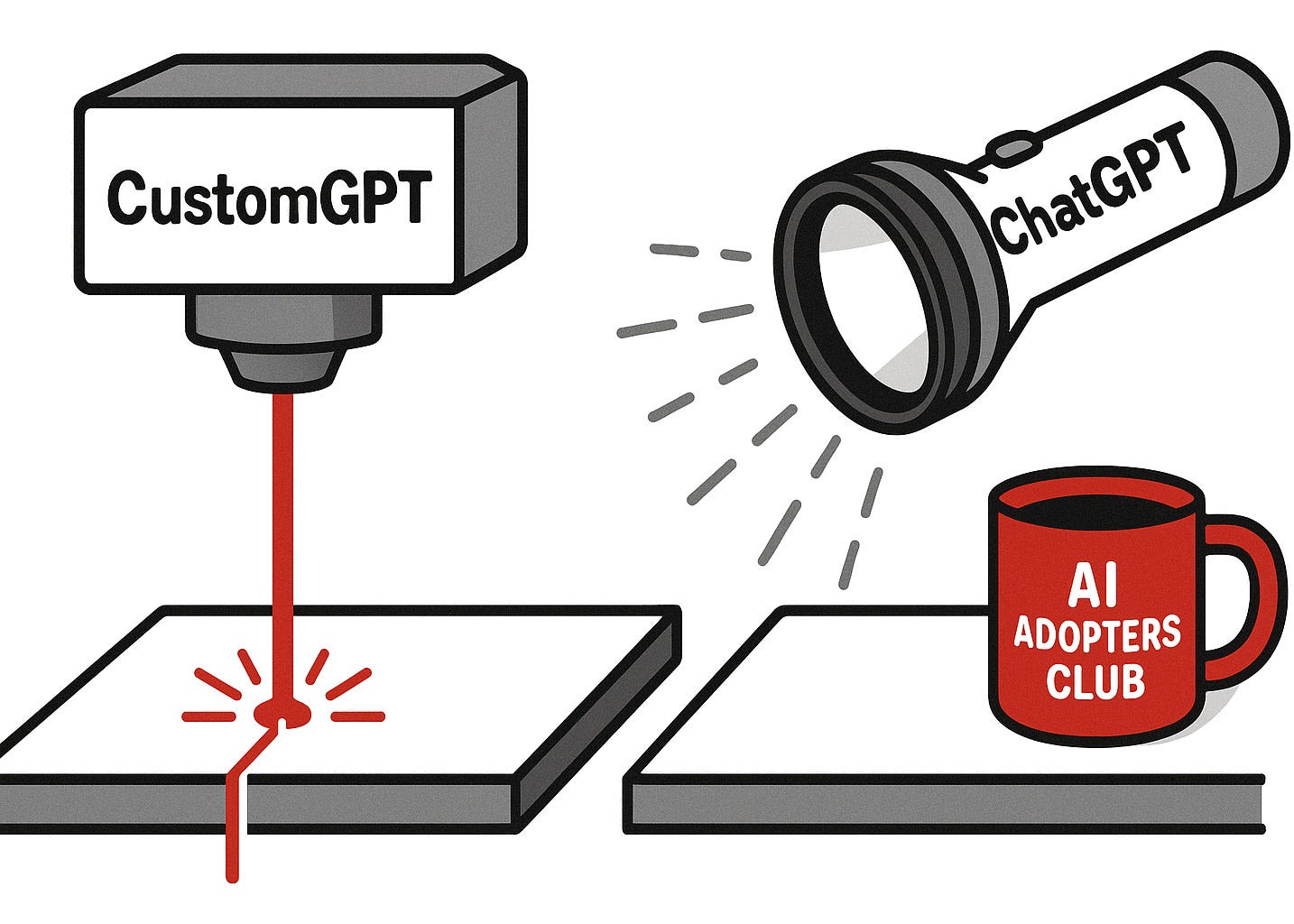The Business Case for Custom GPTs
The step-by-step process for creating valuable workplace assistants
Hey Adopter,
Most Custom GPTs are digital paperweights collecting dust in your sidebar.
They sound impressive in Slack threads but solve no real business problems. A GPT that "helps with marketing" is as useful as a consultant who "does strategy." Vague, unfocused, destined for the digital graveyard.
The real opportunity isn't building another generic helper. It's creating specialized tools that eliminate specific, recurring bottlenecks in your work. The difference between a business asset and a vanity project comes down to one thing: ruthless focus.
Why This Matters for Your Career
Organizations are realizing their expensive AI subscriptions aren't delivering promised productivity gains. The professionals and consultants who can demonstrate measurable results from AI tools become the people everyone wants to hire.
This isn't about having cooler technology. It's about demonstrating your ability to leverage AI potential into business value. That skill builds careers and consulting practices.
What kind of CustomGPT have you or would you like to build? Share your ideas and links in the comments!
What Actually Drives Business Results
Let me cut through the noise and show you Custom GPTs that can solve real problems for ambitious professionals and consultants.
The Build Process That Actually Works
Start with ruthless clarity. Write one sentence nailing the GPT's purpose and audience. "Draft fundraising emails in a warm-but-concise tone for nonprofit directors" beats "help with communications" every time. List three to five success metrics so you know when you're done, not when you're tired.
Collect domain knowledge before touching the builder. Gather reference docs, style guides, past emails, or code snippets the GPT needs to emulate. Clean and dedupe everything so the model sees only canonical information, not your digital junk drawer.
Write bulletproof instructions using structured headers. Most people write instructions like committee memos. Use explicit schemas: ROLE, TONE, TASKS, FORMAT, RULES. This prevents drift in long conversations and makes edits painless.
Upload files strategically. Your knowledge files should be examples of excellence, not archives of everything. Want better emails? Upload the five emails that got the best responses, not every email you've sent. Think training data, not reference library.
Test with edge cases, not friendly questions. Throw incomplete information and contradictory requests at your GPT. If it can't handle workplace communication chaos, it's not ready for real use.
The Advanced Tactics That Matter
Build in self-checking. After generating responses, have the model internally rate compliance with your rules on a one-to-five scale. If below four, it regenerates. This silent loop cuts bad answers before users see them.
Weight retrieval with stars. Put star emojis in front of must-cite paragraphs in uploaded docs. When embeddings generate, the star token boosts similarity and increases retrieval odds for critical information.
Create style anchor files. Add a short file with three to five perfect example responses. Even with thousands of other tokens, these mini-samples strongly influence tone without heavy fine-tuning.
Maintain a shadow changelog. Keep a hidden file documenting every tweak with date and rationale. When the GPT hallucinates, trace which edit caused the problem and roll back fast.
The Business Context That Changes Everything
Think of Custom GPTs as specialized employees who never get tired, never forget training, and work for the cost of a coffee subscription. The question isn't whether to build them. It's whether you can afford not to.
For professionals, they're career accelerants that make you consistently deliver better results faster than colleagues. For consultants, they're scalability engines that turn expertise into repeatable, profitable systems.
The professionals advancing fastest aren't using AI to replace thinking. They're using it to eliminate the routine work that bogs down thinking. Custom GPTs handle the predictable so you can focus on the strategic.
Why Focus Beats Features
Every capability you enable is another way for your GPT to wander off track. The Swiss Army knife approach produces mediocre assistants that do everything poorly instead of one thing exceptionally well.
A GPT that does one specific task brilliantly gets used daily. A GPT that tries to do everything gets forgotten by Friday. Narrow problems create powerful solutions.
The difference between advancing and getting left behind isn't access to AI. It's knowing how to use AI to solve real problems instead of creating digital monuments to your own cleverness.
Stop building GPTs to impress people. Start building them to make work better.
Adapt & Create,
Kamil








This was fascinating to read. Thanks for sharing. Past 2 week I've been playing around custom GPTs for my personal productivity, and I am finding very interesting things. Examples:
I am good at writing, but terrible with CTA, SEO, etc
I created Custom GPTs (tailored in my voice, style, my non-native choose of words in English, etc.) to do these things that I am not good at and also don't care to delegate to AI :)
I am adding my Kolbe Inex MO 4492 into the chats and demanding it challenge my assumptions.